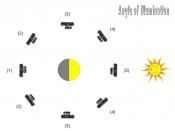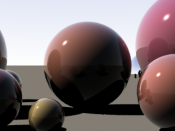1. Perspective distortion and tonal variation are the visual clues which provide a sense of depth or volume, a three-dimensional look to a two-dimensional image. 1)What is "tonal variation?" 2) What two variables work together to produce it?Tonal variation is a clue that our brain uses to perceive depth where there are different tones, including highlight and shadow. The lighting ratios are based on the specific subject as well as personal taste.
The two variables that work together to produce tonal variation are size and position of the light.
2. "The direction of the light relative to the subject determines what part of the subject is highlighted and where the shadows fall."Make a list five possible directions for the light, define each one and describe the positive and negative aspects of each.
front lighting (flat lighting) - the visible part of the subject is entirely highlighted-positive: emphasis placed directly on the subject-negative: the shadow falls behind the subject where the camera cannot see it â the camera sees no tonal variation and therefore, no depthlight on the side of the subject - positioning of the main light on one side of the subject-positive: the combination of highlight and shadow shows dimension-negatives: with a small light a hard shadow is created, which distracts from the primary subject & with a larger light it would soften the shadow, however, the position of the shadow would still compete with the subjectlight above the subject - light placed above and slightly behind the subject-positives: least distracting place for the shadow in most compositions(not very obtrusive) & gives the subject a "ground" on which to sit-negatives: subject does not have as much depth as it needs & shadow is too hardbacklighting-positive: adds drama to the picture-negative: fails to reveal the depth of an object &...


